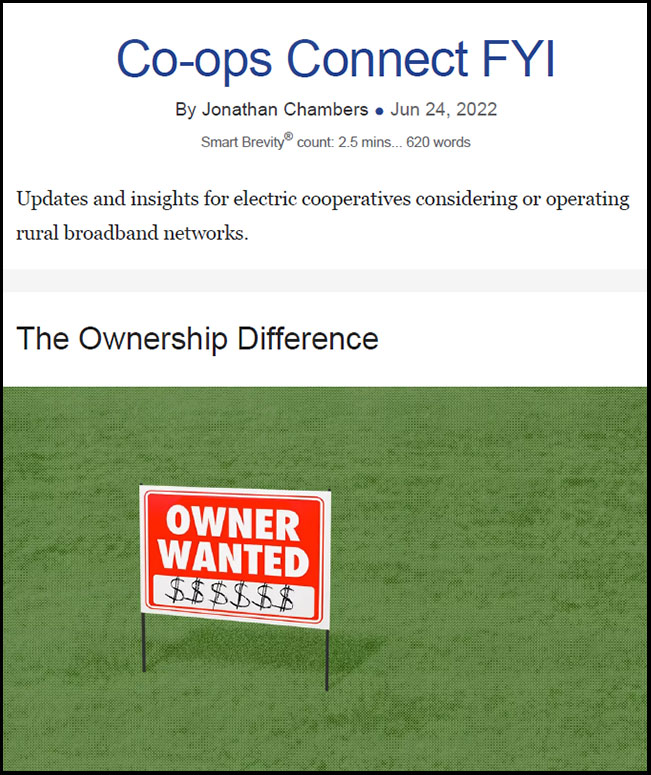The Ownership Difference
June 24, 2022
I was recently reminded that I have been writing the same thing, over and over again, for nearly a decade. Case in point: this blog for the FCC from 2014.
In that blog post, which I wrote while I was a senior official at the FCC, I mentioned a rural broadband workshop.
- Randy Klindt appeared at one of the workshops.
- During one of the workshops, I made the case for local community ownership of broadband networks. (After that workshop, I overheard an AT&T lobbyist refer to my proposal as “totally unworkable.”)
Since I joined Randy at Conexon six years ago, I’ve often been asked how Conexon has been able to build fiber networks for half the cost incurred by telephone and cable companies and other fiber construction firms.
I’ve answered so many times that my response is almost rote: It’s the advantage of working with electric co-ops.
Specifically:
- GIS data
- Access to poles, ducts, conduits, rights-of-way, linemen, and insulated bucket trucks
- Availability of institutional lenders
- An 80-year relationship with the community
- An ongoing relationship with members
- Commitment to service that treats everyone both well and equally
- And, perhaps most importantly: covenant
What truly makes co-op fiber infrastructure different? Ownership.
Why it matters:
In Conexon’s projects, the co-ops, which is to say the members, own the fiber network that provides broadband. To me, that makes all the difference.
One to Watch
Let me provide a concrete example: Twiggs County, Georgia.
- Twiggs is located in the heart of Georgia, in the geographic center of the state.
- The population, according to the 2020 census, is just over 8,000, which is a 10 percent decrease since the 2010 census.
- Twiggs is a persistent poverty county.
Twiggs County is served with electricity by Oconee Electric Membership Corporation.
Most of the county is served with telecommunications service by Windstream, which over the past decade has received over $3,000 in subsidies from the FCC for every rural high-cost household.
Why it matters:
That should have been enough to build a fiber network to every household in the county.
Instead, 3,737 locations in the county are still considered unserved according to the Georgia Broadband Map.
The Choice
What's next:
Earlier this year, Twiggs County was awarded $4.5 million by the state for broadband.
The county council now has a choice to make:
- Windstream, now out of bankruptcy and marketing under the name Kinetic, has indicated it would use the funding to build a fiber network to those parts of the county where it continues to receive funding from the FCC. Windstream would own the network.
- Oconee EMC has indicated it would build a fiber network throughout the county. The members of Oconee EMC (the residents of the county) would own the network.
That’s the crux of the decision before the Twiggs County council:
Should the funding awarded to the county by the state be used to build a network owned by Windstream or by the residents of the county?
The Big Picture
Over the next few years, that choice will play out over and over again in rural communities across the country.
It’s a clear choice and an easy decision.
If I could influence the coming Capital Investment-funded projects and the BEAD-funded projects, I would suggest one overriding priority:
- Not speeds, not transmission media (fiber, coax, spectrum), not technology. Just ownership.
The bottom line:
All other factors being equal, state and federal funds should favor member-owned networks over other business structures.
